
Art and Sculpture in Ubud Temples
Ubud is the heart of Bali’s culture, full of amazing art and sculpture1. Saraswati Temple was built in 1952 by I Gusti Nyoman Lempad. It’s for the Hindu Goddess Saraswati, who loves knowledge and art1.
This temple is open from 7 a.m. to 5 p.m. every day. It shows Bali’s rich culture. You’ll see beautiful stone and wood carvings and a peaceful lotus pond1.
Key Takeaways
- Ubud is famous for its art and temple sculptures, showing Bali’s rich culture.
- The temples in Ubud give a glimpse into Bali’s artistic traditions, with detailed stone and wood carvings.
- Visitors can see the ornate depictions of Hindu deities and mythological creatures at these sacred sites.
- The deep spiritual meaning behind these works shows Bali’s lasting artistic legacy.
- Saraswati Temple, with its iconic lotus pond and frangipani trees, is a prime example of Ubud’s artistic and architectural splendor.
Introduction to Ubud, the Cultural Heart of Bali
Ubud is in the central foothills of Gianyar Regency. It’s the cultural and spiritual heart of Bali23. This town is famous for its arts, nature, and temples that have drawn visitors for ages2.
Ubud has many art galleries, museums, and workshops. You can see paintings, sculptures, and woodwork on Jalan Raya Ubud2. It’s a place where artists, writers, and seekers come together, attracting people from all over2.
Overview of Ubud’s Significance as a Spiritual and Artistic Center
Ubud has been a center for art and spirituality for a long time4. It’s filled with galleries, museums, and workshops. You can see traditional and modern Balinese art at places like Neka Art Museum and Agung Rai Museum of Art (ARMA)4.
The Ubud Art Market has a wide range of handmade items. You can find woodwork and textiles that show the town’s creativity4.
Geographical Location and Accessibility
Ubud is in the heart of Bali and is easy to get to from anywhere3. Bali is part of Indonesia, with over 17,000 islands and a population of nearly 4 million3. You can get to Ubud by airport transfer, ride-hailing, private car, or guided tours2.

“Ubud is a haven for coffee enthusiasts, with cafes like Seniman Coffee Studio and Clear Cafe. They offer expertly brewed coffee and organic menu options.”2
Ubud is a special place with a vibrant art scene and deep spiritual meaning. It’s a place where you can find inspiration, enlightenment, or just enjoy the culture. If you’re going to Bali, you must visit Ubud.
Pura Taman Saraswati: A Photographer’s Dream Destination
Pura Taman Saraswati is just a 5-minute drive from Ubud’s centre5. It’s a stunning water temple complex that draws photographers and visitors5. The temple is dedicated to Saraswati, the Hindu goddess. It has beautiful doors and architecture, perfect for photos5.
Walking through the temple, you’ll see amazing carvings and sculptures5. The lotus ponds offer a calm setting for photos. You might also see a traditional Balinese dance5.
Pura Taman Saraswati is a photographer’s dream in the Ubud temple complex5. It’s great for both experienced and casual photographers. This Ubud water temple will impress your photos and memories.
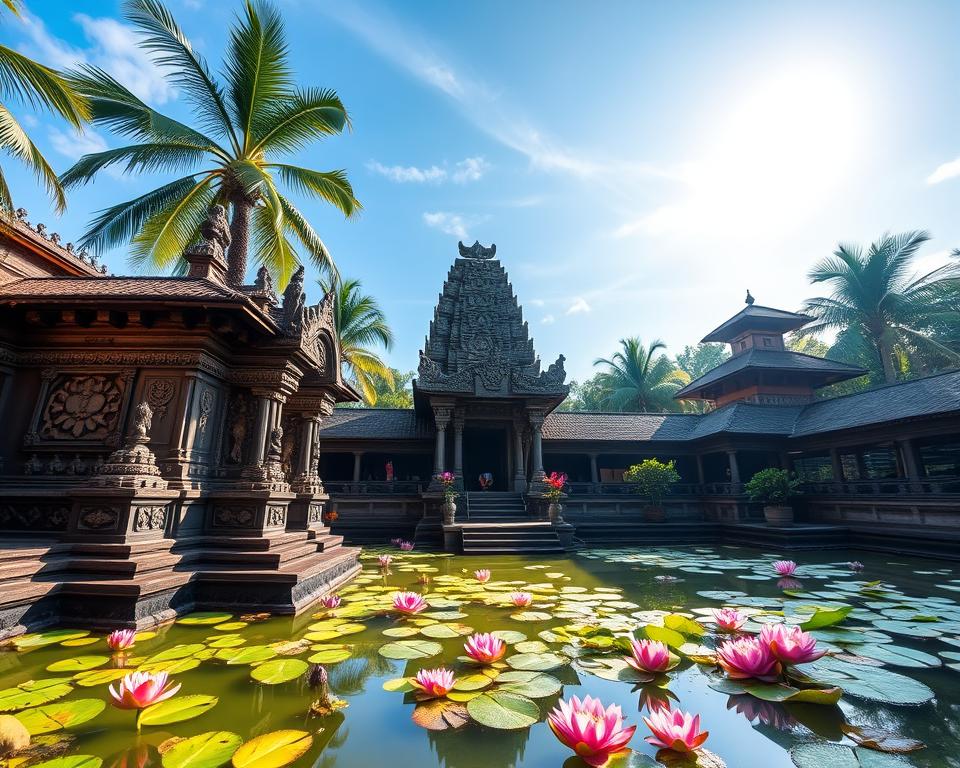
“Pura Taman Saraswati is a true feast for the senses, a place where beauty, spirituality, and creative expression converge in a breathtaking display.” – Balinese Temple Photographer
Pura Dalem: The Bizarre and Intriguing Temple of Death
Outside Ubud, Bali’s cultural heart, is Pura Dalem temple. It’s all about death and has weird but cool statues and carvings6. Every village in Bali has a temple like this, for spirits of death6.
Exploring the Demonic Statues and Carvings
When you get to the temple, you see scary statues and cool gates. There’s a big picture of Rangda, the demon queen, eating babies7. Ubud is known for its mountains, rice fields, and temples7. These carvings show the dark side of Balinese myths and the underworld.
The Significance of Rangda, the Demon Queen
Rangda is a big deal in Balinese stories. She’s shown as very scary6. Every village has a temple for her and other spirits6. Her picture at Pura Dalem reminds us of life and death’s balance in Balinese culture.
“The Pura Dalem temple offers a chilling yet captivating glimpse into the darker realms of Balinese mythology and spirituality. The haunting statues and carvings leave a lasting impression on all who visit this unique and intriguing site.”
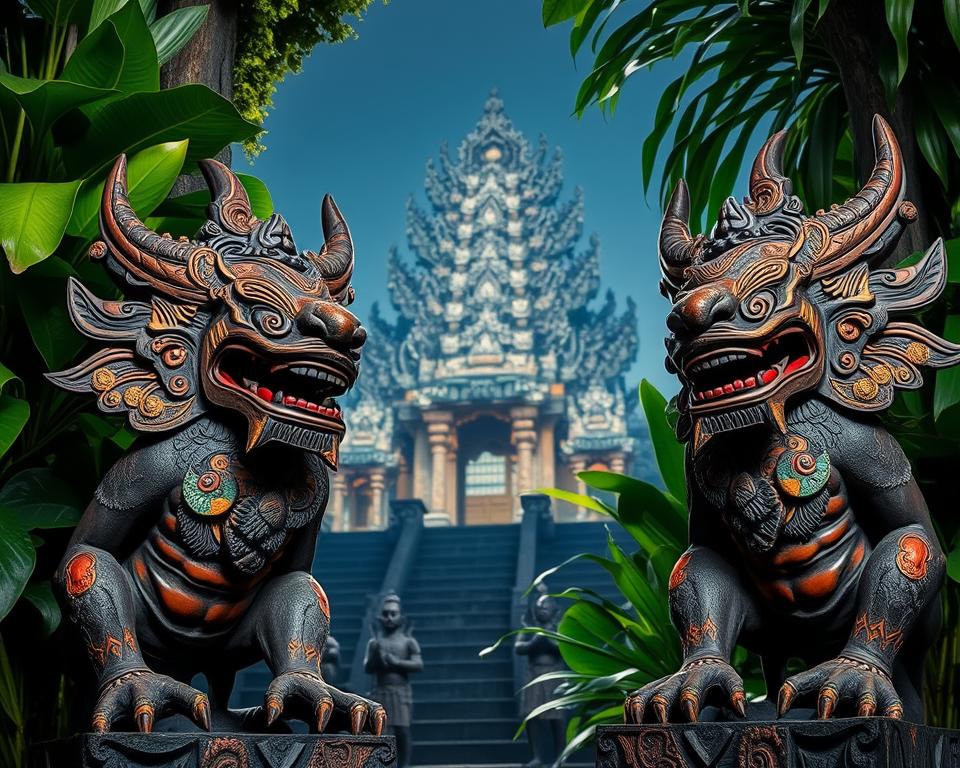
Ubud Sacred Monkey Forest: A Sacred Site Amidst Playful Primates
In Ubud, Bali, there’s a special place called the Ubud Monkey Forest. It’s where nature and magic meet. Here, you can see Balinese temple monkeys and learn about ancient temples8.
The forest is home to about 700 long-tailed macaques. They live in six groups in a 12.5-hectare area8. Walking through, you’ll see monkeys with their own special ways, making it fun and educational8.
There are also three old Hindu temples here, from the 14th century. The most famous is Pura Dalem Agung8. These temples make the forest even more special, showing Bali’s deep culture8.
| Ticket Prices | Weekdays | Weekends |
|---|---|---|
| Adults | IDR 80,000 (USD $5.71) | IDR 100,000 (USD $7.14) |
| Children (3-12 years) | IDR 60,000 (USD $4.29) | IDR 80,000 (USD $5.71) |
The Ubud Monkey Forest is open every day from 9:00 AM to 6:00 PM9. It’s best to go early morning or late afternoon. This way, you avoid the crowds and enjoy the cooler weather9.
Visiting the Ubud Monkey Forest is a special experience. You’ll see monkeys and learn about the temples’ history10. It’s a place where humans and nature live together, showing Bali’s true spirit8.
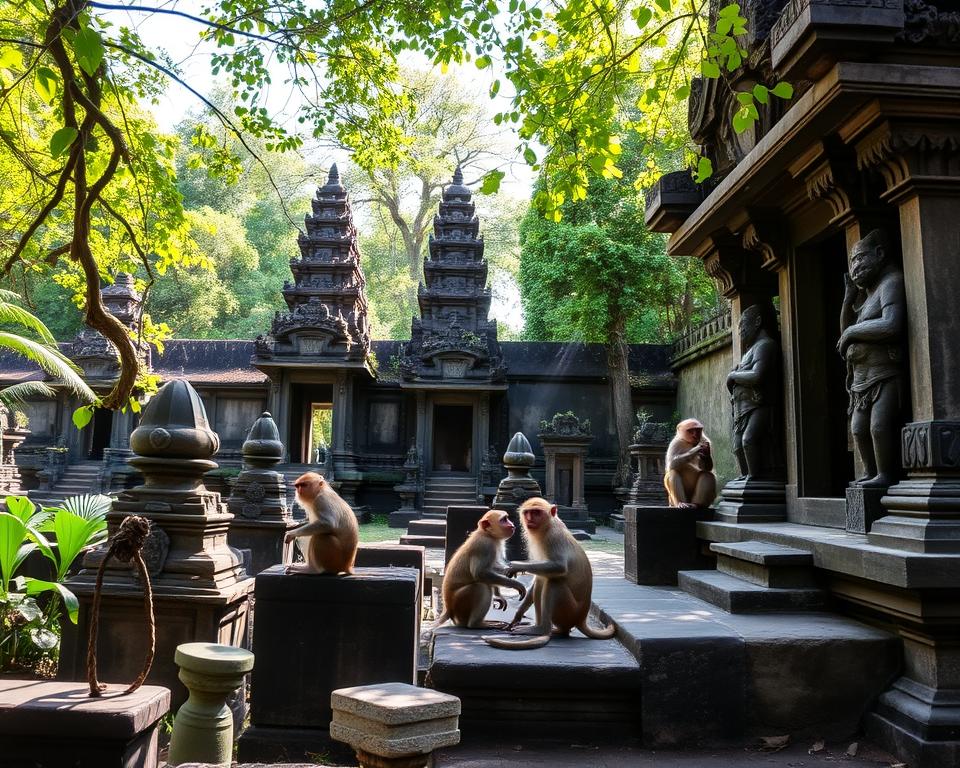
Art and Sculpture in Ubud Temples
In the heart of Bali, Ubud’s temples are famous for their amazing art. They show off the island’s culture with Balinese stone carvings and Balinese wood sculptures11. People can see Hindu deities and myth creatures that are very special. Each piece has deep meaning and shows the skill of Balinese artists12.
Intricate Stone Carvings and Wood Sculptures
Ubud’s temples are full of art. Every part is covered in detailed stone carvings and wooden sculptures. You can see the scary Rangda and the kind Barong. There are also important Hindu deities like Shiva and Vishnu. These art pieces take you into the world of Balinese myths12.
Depictions of Hindu Deities and Mythological Creatures
The temples of Ubud tell stories of gods and demons. You can see the skill of Balinese artists in the carvings and sculptures. For example, the naga creatures that protect the temples are amazing12. These art pieces show the spiritual beliefs of the Balinese people11.
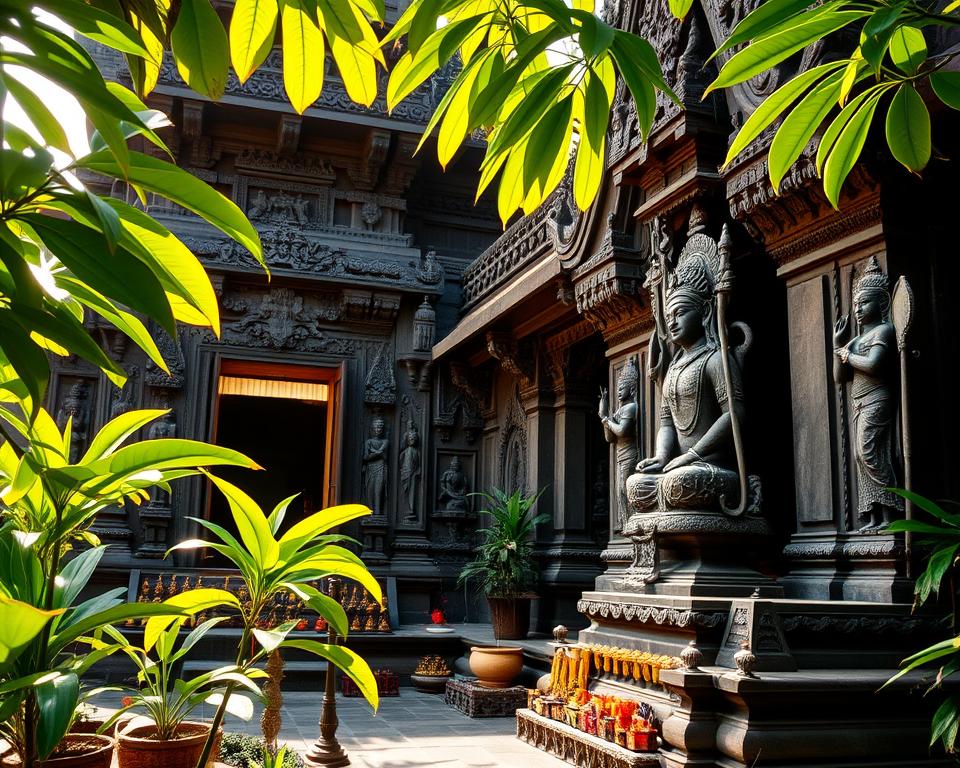
“The temples of Ubud are a veritable treasure trove of artistic expression, with every surface adorned with intricat stone carvings and mesmerizing wooden sculptures.”
In Ubud, each temple shows a different side of Ubud temple art. You can see amazing Hindu deity sculptures everywhere. Places like the Neka Art Museum and the Ubud Art Market are full of beauty11.
When you visit Ubud, you see amazing art and learn about Balinese beliefs. The temples show how gods and demons live together12. These places are a tribute to Balinese art and the hard work of its artists13.
Puri Saren Agung: The Majestic Ubud Palace
The Puri Saren Agung, or Ubud Palace, is in the heart of Ubud. It shows Bali’s royal past14. It’s on Raya Ubud street, Ubud Village, Gianyar Regency, in Ubud’s center14.
The castle has one-meter thick brick walls. This shows its strength and durability14.
History and Architectural Splendor
The Ubud Palace was built in the late 19th century. It was during Tjokorda Putu Kandel’s reign15. It has beautiful art, stonework, and monkey statues that visitors love15.
The royal family of Ubud has a rich history. It goes back to the Majapahit Empire15. The palace hosts traditional ceremonies and cultural shows15.
The palace’s design is by Gusti Nyoman Lempad from the early 20th century16. It has a split gate, pavilions, and lotus ponds15. Visitors can see dances like Legong and Ramayana ballet15.
16 Dance shows cost between 50,000 to 100,000 rupiah (3 to 6 USD) per person16. The palace is open from 8 a.m. to 7 p.m. daily16. Visitors must wear modest clothes and can borrow or rent sarongs and sashes onsite16.
16 Visit early morning or late afternoon for fewer crowds14. Puri Saren Agung has dance shows every evening. You can take great photos around the palace14.
14 The palace was once the king’s home. It’s now a tourist spot14. It has statues, carvings, and golden doors14. It shows Bali’s beauty and culture14.
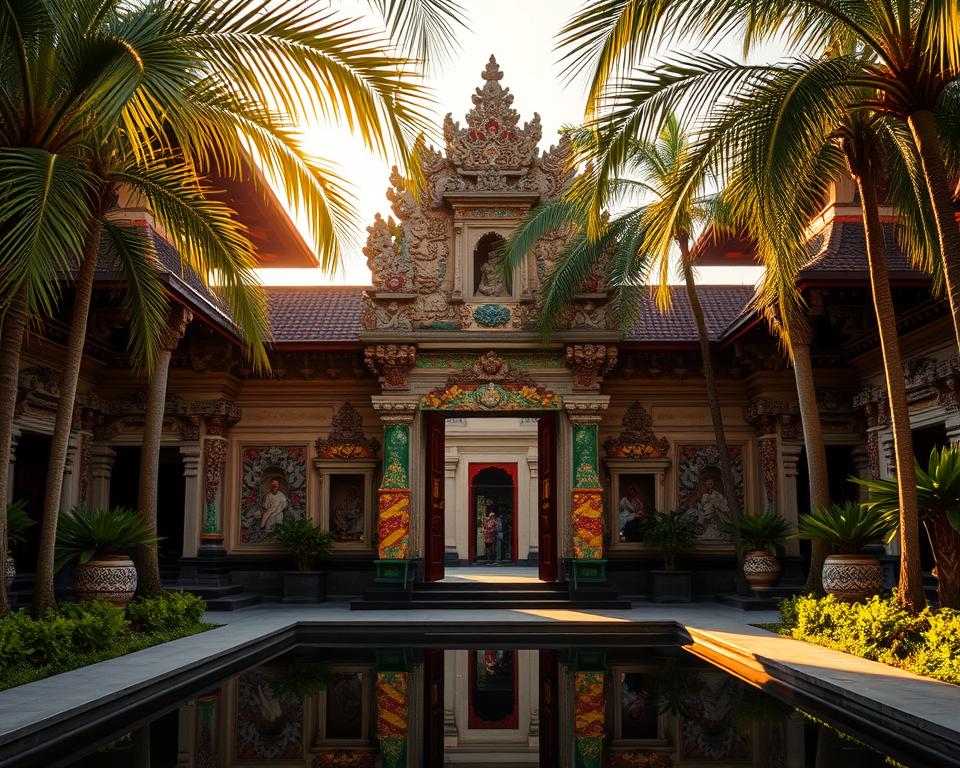
The temple inside is closed to visitors. But, the rest of the site is open. It’s a great way to see Bali’s culture and architecture.
Gunung Lebah Temple: A Tranquil Jungle Retreat
The Gunung Lebah Temple is hidden in Ubud’s greenery. It was started by Hindu priest Rsi Markendeya. This temple is quiet and has beautiful views of the Cerik River17.
People looking for Balinese meditation and Bali’s sacred sites love this temple. It’s away from the busy places17.
The temple is surrounded by the Ubud jungle. It’s very peaceful. Visitors can relax and feel the temple’s spiritual vibe17.
Visitors can see the temple’s detailed carvings and architecture. They learn about Balinese Hindu traditions. This Ubud jungle temple is very special17.
“The Gunung Lebah Temple is a hidden gem, giving a rare chance to feel Bali’s peace and spirituality away from crowds.”
If you want a quiet break from Ubud’s busy streets, or to learn more about Balinese culture, visit the Gunung Lebah Temple17.
Goa Gajah: The Enigmatic Elephant Cave
Goa Gajah, or Elephant Cave, is near Ubud in Bali. It’s a Hindu site from the 11th century18. The first mention was in 1365 in a Javanese poem18.
Its entrance looks like a scary mouth. It might show the Hindu earth god Bhoma or a witch from Balinese stories18.
The Elephant Cave is small but famous18. It shows Bali’s history and the skills of its old builders. It was even up for UNESCO World Heritage in 199518.
Inside, you can see a Ganesh statue and a Shiva worship area18.
Exploring the Monstrous Carved Entrance and Ancient Ruins
People have been exploring Goa Gajah for over 90 years19. Big discoveries were made from 1954 to 197919. In 1931, Mr. Conrat Spies found the first pieces here19.
The Indonesian Antiquities Agency started studying it in 195019. In 1951/1952, they found two stone pieces while cleaning19.
It was once a place for monks to meditate19. Now, it’s a place for worship. Visitors must be quiet and not take photos when people are praying18.
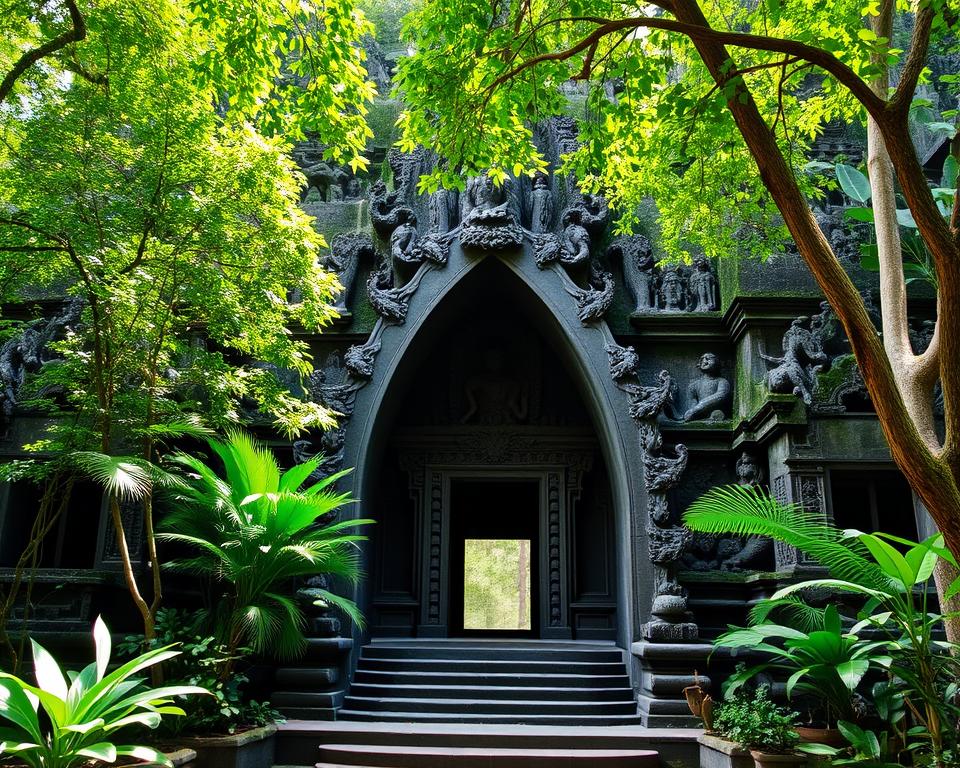
Visitors also see rice paddies, gardens, and a waterfall nearby18. But, there are no signs in English to explain the history18.
| Key Facts about Goa Gajah | Details |
|---|---|
| Location | Bedulu Village, Gianyar, Bali |
| First Mention | Javanese poem Desawarnana, 1365 |
| Entrance Fee | Approximately 15,000 rupiah ($1.15) |
| Opening Hours | 8 a.m. to 4:30 p.m., 7 days a week |
| Dress Code | Knees must be covered, sarongs available |
| UNESCO Status | Tentative World Heritage Site, 1995 |
| Nearby Attractions | Rice paddies, gardens, stone steps, waterfall |
“Goa Gajah is a significant Hindu archaeological site that offers a unique glimpse into Bali’s rich history and the ingenuity of its ancestral builders.”
Samuan Tiga Temple: A Hidden Gem of Intricate Stonework
The Samuan Tiga Temple is hidden just 800 yards from Ubud’s main town20. It’s a 10th-century site with amazing stonework21. It was once Buddhist but now honors the Hindu Trinity. It’s a peaceful spot for those wanting to see Ubud’s culture.
Ubud is Bali’s cultural heart20. It has over 20,000 Hindu temples21. The Samuan Tiga Temple is a hidden treasure here, giving visitors a calm experience unlike other temples in Bali21.
The temple’s stonework and calm vibe make it special21. Visitors can see the detailed carvings and sculptures on the walls and structures. They can learn about Balinese Hindu-Buddhist architecture here21.
The Samuan Tiga Temple is perfect for those wanting to explore Ubud’s culture21. It’s a quiet place to see the beauty of Balinese stonework and learn about its history21. It’s a must-see for photographers, culture lovers, or anyone looking for peace in Ubud.
Conclusion
The temples of Ubud in Bali are truly amazing. They show the island’s rich22 art and architecture. Places like Pura Taman Saraswati, Goa Gajah, and Samuan Tiga give us a deep look into Bali’s culture and faith22.
Visiting these temples lets you see the amazing art and carvings. You’ll learn to love the skill and creativity of Ubud’s culture. These temples are not just spiritual places but also show Bali’s lively22 art scene.
Seeing the statues at Pura Dalem or the calm of Saraswati Temple is special. You’ll also find hidden gems like Gunung Lebah. Your trip to Ubud’s temples will make you appreciate Bali’s spiritual history more.
FAQ
What makes Ubud renowned for its art and sculpture?
Ubud is famous for its art and temple sculptures. These show Bali’s rich culture. You can see amazing stone and wood carvings in Ubud’s temples.
What is the significance of Ubud as a cultural and spiritual center in Bali?
Ubud is Bali’s cultural and spiritual heart. It’s known for its arts, nature, and temples. The town has a long history of art and Hindu beliefs.
What are some of the must-visit temples in Ubud known for their exceptional art and sculpture?
Must-see temples in Ubud include Pura Taman Saraswati and Pura Dalem. Also, the Ubud Sacred Monkey Forest and Puri Saren Agung are famous. Don’t miss Gunung Lebah and Samuan Tiga Temple for their stunning art and sculptures.
How can visitors explore the art and sculpture in Ubud’s temples?
Visitors can see Hindu deities like Shiva and Vishnu in the temples. You’ll also find mythological creatures like Rangda and Barong. These show the skill of Balinese artists.
What makes Ubud’s temples unique in terms of their art and architecture?
Ubud’s temples show Bali’s rich culture and art. They offer a peek into Bali’s traditions and beliefs. From Pura Taman Saraswati to Goa Gajah, they are truly special.
Source Links
- https://finnsbeachclub.com/guides/pura-taman-saraswati-bali-temple/
- https://come2indonesia.com/journey-to-ubud-bali-indonesia/
- https://alamindahbali.com/page/aboutbali
- https://medium.com/@ashi.digiperformer/exploring-ubud-the-cultural-heart-of-bali-7700eabe59d0
- https://www.balicasa-properties.com/bali/gianyar/
- https://www.thenotsoinnocentsabroad.com/blog/weird-bali-7-crazy-balinese-customs
- https://finnsbeachclub.com/guides/best-temples-in-ubud-bali/
- https://balitourhost.com/discover-the-wonders-of-the-sacred-monkey-forest-ubud/
- https://www.balicheapesttours.com/ubud-monkey-forest.html
- https://pickyourtrail.com/attractions/ubud-monkey-forest-bali
- https://www.comohotels.com/stories/a-day-in-ubud
- https://www.thenotsoinnocentsabroad.com/blog/pura-dalem-ubud-the-temple-of-death
- https://budayabali.com/mas-ubud-village-the-enchanting-center-of-balinese-wood-carving-art
- https://visitbali.id/property/puri-saren-agung-ubud-historical-heritage
- https://ubudkayahouse.com/article/puri-saren-agung-ubud-palace
- https://www.tripoto.com/bali/places-to-visit/ubud-palace
- https://bucketlistbums.com/single-post/ubud/
- https://www.tripsavvy.com/goa-gajah-eerie-elephant-cave-in-bali-1629094
- https://balistarisland.com/bali-tourist-attractions/gua-gajah/
- https://www.vilondo.com/where-to-stay-in-bali/ubud-guide/
- https://thingstoseeinubudbali.com/what-are-the-best-must-see-temples-to-visit-in-ubud-bali/
- https://dibalitour.com/ubud-art-village/